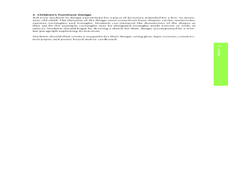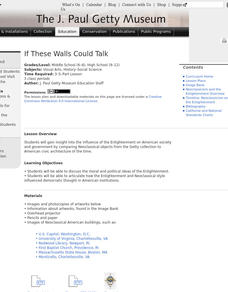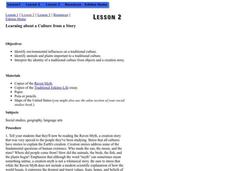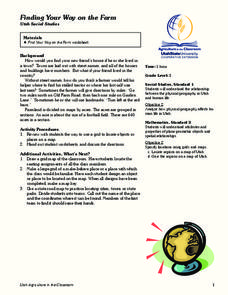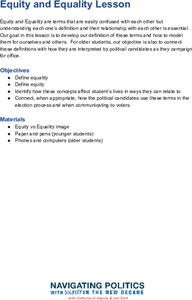Curated OER
Ideal Objects
Students make connections between two design objects intended for different purposes and analyze the social and political meaning in the designs. In this design analysis lesson, students complete image based discuss activities. Students...
Smithsonian Institution
World War II
December 7th is remembered as a tragic time in American history, but some scholars may not know why. The resource explains the significance of the bombing of Pearl Harbor as well as how World War II relates to American history. The...
Curated OER
Excited About Flight!
Students create flying objects by using materials given in 3 different flight centers. In this flight lesson plan, students go to each center and have a discussion about each one.
Curated OER
Everyday Objects As Artwork
Young scholars examine everyday Chinese objects and analyze why they are
considered artwork today in this multi-subject lesson plan for Middle School. Small group colaboration is emphasized.
National Woman's History Museum
Create your own Women’s History Museum
Celebrate Women's History with a museum display. Divide the class into seven groups and assign each a different historical topic/time period. Each group member researches a different woman of that time period and creates an exhibit that...
Curated OER
Can You Afford to Retire?
Students participate in a game in which one group acts as the company and the other group acts as the employees. They examine what happens when the company files for bankruptcy. They discover labor strategies as well.
Curated OER
If These Walls Could Talk
Students compare Neoclassical objects from the Getty collection to American civic architecture of the time. They discuss the moral and political ideas of the Enlightenment and articulate how these art forms influenced democratic thought...
Curated OER
School Sleuths Treasure Map
Students are explained how a grid and compass work. They are also explained that archaeologists use grids as a record of the exact location of artifacts. Students define the term datum as a point of reference on grids from which all...
Curated OER
Learning about a Culture from a Story
Students interpret the identity of a traditional culture from objects and a creation story. In this lesson on learning about a culture from a story, students read and analyze an Eskimo myth about creation and an essay on Traditional...
Curated OER
Finding Your Way on the Farm
Third graders make a grid map. In this directionality lesson plan, 3rd graders review how to use a grid to locate objects or places on a map. Students draw a grid map of the classroom and locate seating assignments. Students create a...
Curated OER
You're In My Space!
Young scholars explain how political, social, and economic boundaries can be changed through cooperation and conflict. Small groups are assigned a particular trouble area of the world. Each group studies a particular side of the conflict.
Cultures of Dignity
Equity and Equality Lesson
Equality does not equal equity and this lesson explains why. Class members compare two images--one labeled "Equality" and the other "Equity." Using the provided discussion questions, they then develop definitions that distinguish between...
Curated OER
Where Is It?
Students practice their writing skills for describing place and location using prepositions. They find hidden objects and report to a recorder the exact directions for finding that object. Recorders write the directions.
Curated OER
Physical Differences
Students read the book We Can Do It! and discuss how we are all physically different. In this physically different lesson plan, students read the book, discuss their differences, and participate in a smelling and touching activity to see...
Curated OER
Archaeology of the Future
Middle schoolers view pictures of classmates' homes, make list of different objects in picture, and discuss what they can tell about place from evidence in picture. Students then observe artifact pictures, and read and complete artifact...
Curated OER
Supply and Demand
Fifth graders discuss the affects of supply and demand on prices and purchasing habits. Given a scenario, student groups discuss how demand and other factors can affect the price of an object. They predict a change in price dependent...
Curated OER
Archeology of the Future
Students are introduced to the basic vocabulary of archeology. Using the vocabulary, they classify artifacts and make inferences about their uses. In groups, they create a chart for the criteria needed to analyze artifacts and share...
Curated OER
The Multicultural Person
Students begin the lesson by putting themselves into different groups based on different criteria. As a class, they brainstorm a list of characteristics in which they all share. To end the lesson, they discuss how it felt to be put in...
Curated OER
Be a Responsible Citizen: Vote!
Pupils explore American citizens' rights and responsibilities through group research on the Internet and develop a presentation for the class.
Curated OER
Traveler's Trunk
Pupils analyze and interpret artifacts from the 1920s and explore the Great Migration. In this 1920s history lesson, students review background information about the Great Migration and use artifacts to study history of Chicago. Pupils...
Curated OER
History Detectives
Fifth graders investigate the significant events in America's history. Students listen to a variety of books based on significant historical events in America. Students divide into 6 groups, each of which is responsible for researching...
Curated OER
The Golden Spike
Students investigate modern transportation in the 19th century by examining artifacts. In this U.S. history lesson, students read the story Joseph's Railroad Dreams, and discuss the Golden Spike used in the first transcontinental...
Curated OER
Newspaper Creations
Students complete different building tasks using newspapers like building structures or costumes. In this newspaper lesson plan, students are judged on their creations in teams.
Curated OER
Artifacts: What Am I?
Pupils practice simple Japanese expressions. They explore the information available from artifacts. Groups of students attempt to figure out other groups culture by examining a series of artifacts in a paper bag.
